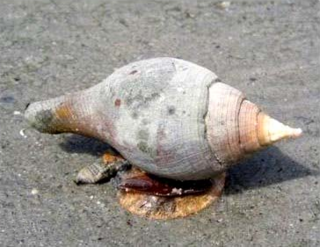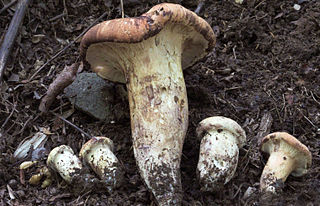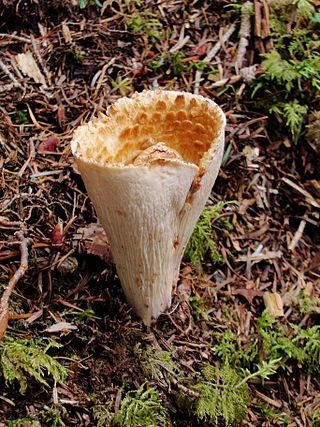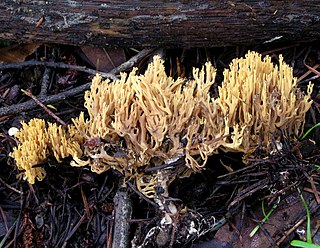
The Gomphaceae are a diverse family of fungi belonging in what is classically known as the Phallales or cladistically as the gomphoid-phalloid clade. The family has 13 genera and 287 species.

Gomphus is a genus of cantharelloid fungi in the family Gomphaceae. Once presumed to be related to chanterelles, molecular study has shown them to be allied with stinkhorns and fairy clubs. The type species of the genus is the pig's ear (G. clavatus).

Turbinellus floccosus, commonly known as the scaly vase, or sometimes the shaggy, scaly, or woolly chanterelle, is a cantharelloid mushroom of the family Gomphaceae native to Asia and North America. It was known as Gomphus floccosus until 2011, when it was found to be only distantly related to the genus's type species, G. clavatus. It was consequently transferred from Gomphus to Turbinellus. The orange-capped vase- or trumpet-shaped fruiting bodies may reach 30 cm (12 in) high and 30 cm (12 in) wide. The lower surface, the hymenium, is covered in wrinkles and ridges rather than gills or pores, and is pale buff or yellowish to whitish.

Vasum, common name the vase snails or vase shells, is a genus of mostly rather large predatory sea snails, marine gastropod mollusks in the subfamily Vasinae within the family Turbinellidae.

Turbinella is a genus of very large sea snails with an operculum, marine gastropod mollusks in the subfamily Turbinellinae of the family Turbinellidae.

Gomphus clavatus, commonly known as pig's ears or the violet chanterelle, is an edible species of fungus in the genus Gomphus native to Eurasia and North America. Described by Jacob Christian Schäffer in 1774, G. clavatus has had several name changes and many alternative scientific names, having been classified in the genus Cantharellus, though it is not closely related to them. The fruit body is vase- or fan-shaped with wavy edges to its rim, and grows up to 15–16 cm wide and 17 cm tall. The upper surface or cap is orangish-brown to lilac, while the lower spore-bearing surface, the hymenium, is covered in wrinkles and ridges rather than gills or pores, and is a distinctive purple color.

Gloeocantharellus is a genus of fungi in the family Gomphaceae. It contains 12 species that are found in mainly tropical and subtropical regions.

Tuber is a genus in the fungal family Tuberaceae, with estimated molecular dating to the end of the Jurassic period. It includes several species of truffles that are highly valued as delicacies.

Ramaria flaccida is a species of coral fungus in the family Gomphaceae. Originally described as Clavaria flaccida by Elias Fries in 1821, the species was transferred to Ramaria by Hubert Bourdot in 1898.

Phaeoclavulina abietina, commonly known as the green-staining coral, is a coral mushroom in the family Gomphaceae. It is characterized by the green staining reaction it develops in response to bruising or injury.

Turbinellus is a genus of five species of fungi in the family Gomphaceae.

Ramaria cokeri is a coral mushroom in the family Gomphaceae. It was described in 1976 from the Appalachian Mountains in the United States. Some authors have proposed to place the species in a separate genus Phaeoclavulina based on molecular analyses, but this was explicitly rejected in a subsequent publication due to the resulting morphological variability of the resulting genus.
Gomphus brunneus is a species of fungus in the genus Gomphus, family Gomphaceae. It has been recorded from rainforest in the Yucatan Peninsula in Mexico, as well as Uganda and Democratic Republic of Congo in Africa.
Gomphus crassipes is a species of fungus in the genus Gomphus, family Gomphaceae. It is native to Spain and North Africa and possibly threatened by habitat loss.

Turbinellus kauffmanii, is a species of mushroom native to North America.
Turbinellus stereoides, previously known as Gomphus stereoides, is a mushroom in the family Gomphaceae. It was originally described in 1996 by E. J. H. Corner as a species of Gomphus. The type collection was made in 1930 in Slim River, Malaysia.

Turbinellus fujisanensis, previously known as Gomphus fujisanensis, is a mushroom in the family Gomphaceae. It was originally described in 1941 by Sanshi Imai as a species of Cantharellus. Admir Giachini transferred it to Turbinellus in 2011. The genus Gomphus, along with several others in the Gomphaceae, was reorganized in the 2010s after molecular analysis confirmed that the older morphology-based classification did not accurately represent phylogenetic relationships.

Ramaria myceliosa is a species of coral fungus in the family Gomphaceae. Found in North America, it was originally described by Charles Horton Peck in 1904 with the name Clavaria myceliosa. The type was collected by botanist Edwin Bingham Copeland in the mountains near Stanford University in California. E.J.H. Corner transferred it to the genus Ramaria in 1950. Giachini and colleagues proposed that Ramaria myceliosa is the same species as the European Phaeoclavulina curta, but did not provide molecular evidence to support their suggested synonymy. In a recent (2014) publication on California fungi, the authors propose the transfer of Ramaria myceliosa to the genus Phaeoclavulina, but as of January 2016, this transfer has not been accepted by either MycoBank or Index Fungorum.

Gloeocantharellus purpurascens, commonly known as the Indian Creek mushroom or violet-staining chanterelle, is a species of fungus in the family Gomphaceae native to North America and French Guiana.
Pissonotus flabellatus is a species of delphacid planthopper in the family Delphacidae. It is found in North America.












